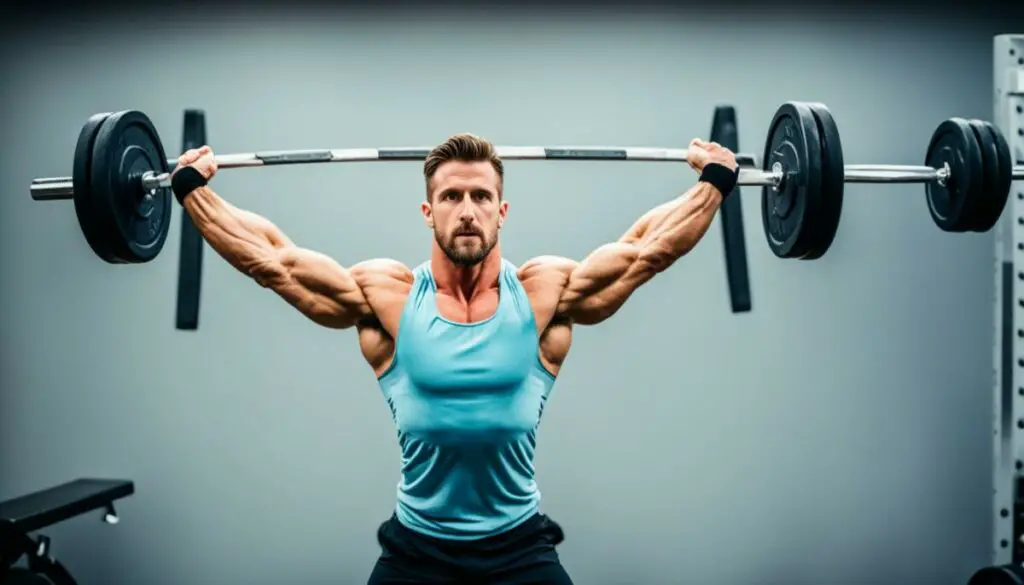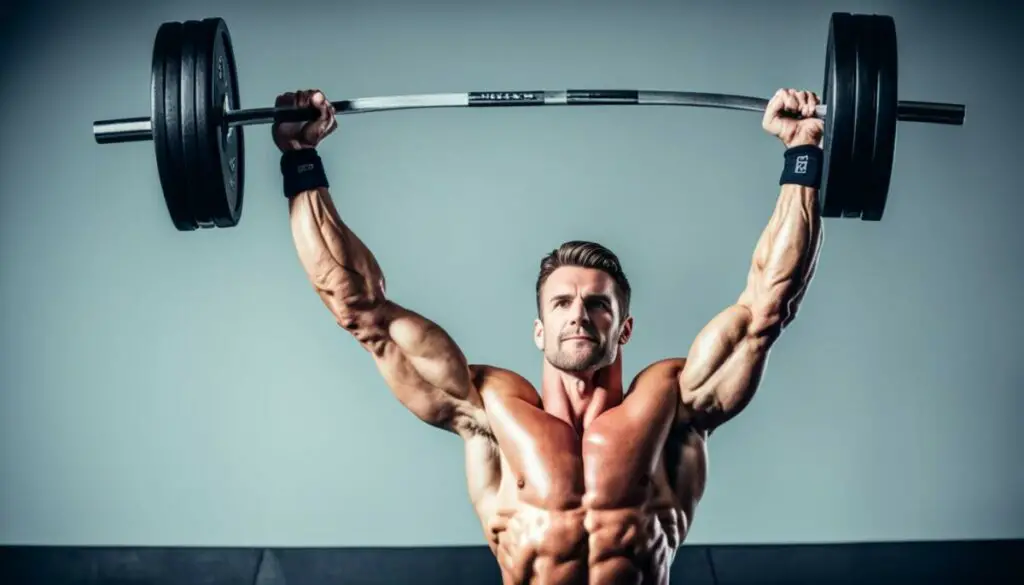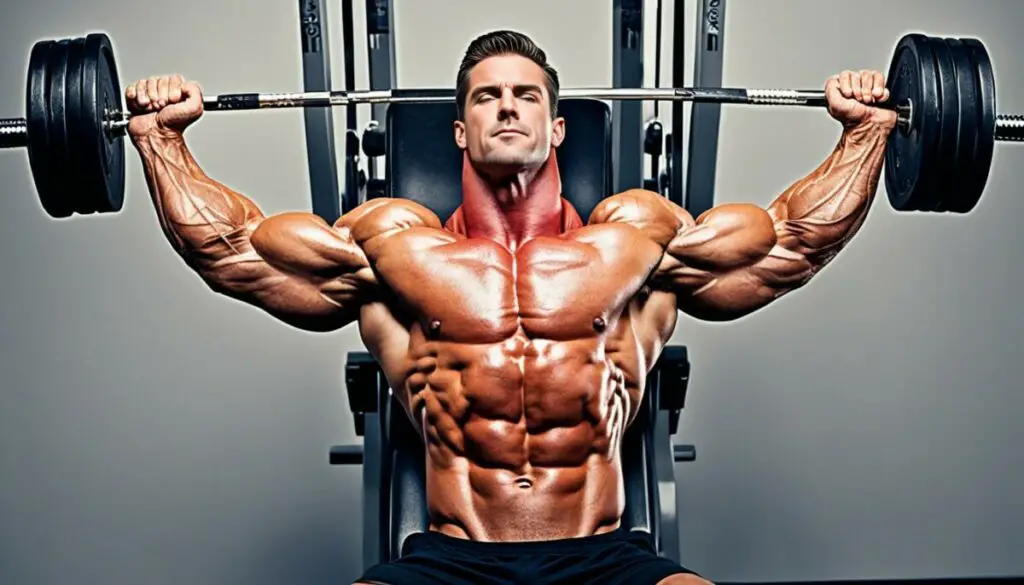Last Updated on 3 months by Francis
Welcome to our guide on the shoulder press, also known as the overhead press. If you’re looking to unlock your strength and achieve a powerful upper body, you’re in the right place. The shoulder press is a fundamental compound movement that offers numerous benefits for your fitness journey.
The shoulder press is an exercise that targets multiple muscle groups in your upper body, including the shoulders, triceps, and upper back. By incorporating this exercise into your routine, you can build strength, improve posture, and enhance overall athletic performance.
Before diving into the benefits, it’s essential to ensure that you have proper shoulder mobility and core strength. These prerequisites will help you perform the shoulder press safely and effectively. Starting with dumbbell or landmine press variations can be a great way to work on your overhead mechanics while minimizing stress on the wrists, elbows, and shoulders.
Contents
Key Takeaways:
- The shoulder press is a foundational compound movement that strengthens the upper body and tests upper body stability.
- Proper shoulder mobility and core strength are essential before attempting the overhead press.
- Starting with dumbbell or landmine press variations can help with proper overhead mechanics.
- The shoulder press targets multiple muscle groups, including the shoulders, triceps, and upper back.
- Incorporating the shoulder press into your routine can lead to improved strength, power, and overall athletic performance.
How to Perform the Shoulder Press Correctly

When it comes to the shoulder press, proper form is essential for maximizing results and minimizing the risk of injury. Follow these steps to ensure you perform the shoulder press correctly:
1. Setup: Place your hands just outside shoulder width apart on the barbell. Keep your elbows and forearms in a vertical position. The bar should rest on the heel of your palm, with the middle knuckles facing upwards.
2. Position: Stand with your feet shoulder-width apart and maintain a slight bend in your knees. Engage your core and maintain a neutral spine throughout the movement.
3. Initiate the Press: Begin the movement by pressing the barbell overhead, fully extending your arms while keeping your wrists straight. Exhale as you press the weight up.
4. Lockout: At the top of the movement, lockout your elbows without fully hyperextending them. This ensures that you engage the muscles effectively and maintain proper joint alignment.
5. Lower the Weight: Slowly lower the barbell back to the starting position, maintaining control throughout the descent. Inhale as you lower the weight.
It’s important to note that there are variations of the shoulder press that you can try to target different muscle groups and add variety to your routine. Some popular variations include the dumbbell shoulder press, standing military press, and seated shoulder press.
Remember, mastering the correct technique is vital for achieving the best results and preventing injuries. Start with lighter weights and gradually increase the load as your form improves. It’s always a good idea to work with a qualified trainer to ensure you’re using proper technique.
Common Mistakes to Avoid
- Flaring or Tucking the Elbows: Keep your elbows in line with your wrists throughout the movement. Avoid excessively flaring or tucking your elbows, as this can strain the shoulder joint.
- Using Momentum: Avoid using momentum to lift the weight. Focus on controlled and deliberate movements, engaging the targeted muscles throughout the entire exercise.
- Overarching the Lower Back: Maintain a neutral spine throughout the shoulder press. Avoid overarching your lower back, as this can lead to lower back strain and injuries.
By following these guidelines and practicing good form, you can safely and effectively perform the shoulder press exercise to target your shoulder muscles and build upper body strength.
| Benefits of Correct Shoulder Press Technique |
|---|
| Improved muscle development in deltoids, trapezius, and triceps |
| Enhanced shoulder stability and mobility |
| Increased upper body strength |
| Promotes better posture and alignment |
| Reduced risk of shoulder injuries |
“Correct technique is the foundation of effective strength training. Take the time to learn and practice the proper form for shoulder presses to reap the full benefits and protect your joints.”
Benefits of the Overhead Press: Improved Core Strength

One of the key benefits of the overhead press is improved core strength. To maintain proper form during the press, your core needs to be strong and engaged. By using progressive overload during training, you not only strengthen your shoulders but also improve core stability and strength.
Having a strong and stable core is essential for overall functional fitness and athletic performance. Your core muscles, including the abdominals, obliques, and lower back, play a crucial role in stabilizing your body during the overhead press movement. The engagement of these muscles helps to maintain proper alignment and prevent excessive arching of the lower back.
The overhead press specifically targets the core muscles to maintain a stable position and prevent any compensations or excessive sway of the hips. As you press the weight overhead, the core muscles are constantly engaged to stabilize your torso and maintain proper alignment.
Improved core strength not only enhances your performance in the overhead press but also translates to other exercises and everyday activities. A strong core provides a solid foundation for various movements, such as lifting heavy objects, performing compound lifts like squats and deadlifts, and even improving your posture.
Benefits of Improved Core Strength:
- Enhanced stability and balance
- Reduced risk of lower back pain and injuries
- Improved posture and alignment
- Increased power and efficiency in athletic movements
- Greater overall functional strength
By incorporating the overhead press into your training routine, you can strengthen your core and experience these benefits both inside and outside the gym. Not only will you develop impressive shoulder strength, but you will also transform your core into a solid pillar of stability.
My core strength has significantly improved since I started including the overhead press in my workouts. It has helped me develop a stronger and more stable torso, which has enhanced my performance in other exercises as well. I highly recommend incorporating this exercise to anyone looking to improve their core strength and overall athleticism.
Benefits of the Overhead Press: Bigger Shoulders

The overhead press is an essential exercise for those looking to increase shoulder size and strength. By primarily targeting the anterior and medial deltoids, the overhead press helps develop the muscles responsible for shoulder size and overall upper body strength.
If you want bigger, stronger shoulders, the overhead press is a necessary addition to your workout routine. While shoulder raise variations can provide some benefits, they can only take your shoulder size and strength so far. To achieve significant shoulder growth, the overhead press is the key.
With consistent training and progressive overload, you can see noticeable improvements in the size and definition of your shoulders. Not only will this enhance your physique, but it will also contribute to better shoulder stability and overall upper body strength.
Benefits of the Overhead Press: Bigger Shoulders
| Benefits | Description |
|---|---|
| Increased Shoulder Size | The overhead press targets the anterior and medial deltoids, leading to increased muscle mass and definition in the shoulders. |
| Improved Upper Body Strength | Building bigger shoulders through the overhead press contributes to overall upper body strength and power. |
| Enhanced Shoulder Stability | Developing shoulder strength and size helps improve stability, reducing the risk of injury during other upper body exercises. |
Give your shoulders the attention they deserve with the overhead press, and enjoy the benefits of bigger, stronger shoulders that enhance your overall physique and upper body performance.
Benefits of the Overhead Press: Better Bench Press Technique

A strong overhead press can have a positive impact on your bench press technique, allowing you to perform better and maximize your gains. While both exercises work similar muscle groups such as the triceps, deltoids, and chest, they target them from different angles, providing unique benefits. One key area that the overhead press strengthens is the upper back, which plays a larger role in overhead pressing and can help reinforce better bench technique.
Strengthening your upper back through the overhead press can directly improve the eccentric part of the bench press, allowing for a more controlled and efficient movement. It also aids in maintaining proper posture and stability during the bench press, reducing the risk of injury and allowing you to lift heavier weights with confidence.
Furthermore, the overhead press helps to improve overall upper body strength and muscle coordination, which are essential for maintaining proper bench press form. By incorporating the overhead press into your training routine, you can develop the necessary strength, stability, and technique to enhance your bench press performance.
Key Benefits of Overhead Press for Better Bench Press Technique:
- Strengthening the Upper Back: The overhead press targets the upper back muscles, which contribute to better bench press technique and stability.
- Improved Posture and Stability: By strengthening the upper body and core through overhead pressing, you can maintain better posture and stability during the bench press, resulting in more controlled and efficient lifts.
- Enhanced Muscle Coordination: Performing the overhead press helps improve muscle coordination, enabling you to execute the bench press with proper form and technique.
- Injury Prevention: Strengthening the supporting muscles and improving overall upper body strength can reduce the risk of injury during bench press exercises.
By incorporating the overhead press into your training routine, you can enhance your bench press technique, increase strength and stability, and take your upper body strength to new heights. Remember to focus on proper form and gradually increase the weight as you progress.
Benefits of the Overhead Press: Improved Lockout Strength And Power
Developing strength in your upper body, particularly in the triceps, can significantly enhance your overall upper body power. Through the overhead press, you can increase triceps strength and size, which is crucial for excelling in lifts that require an overhead position, such as Olympic lifts, overhead carries, and overhead squats. The overhead press is an effective exercise for targeting and strengthening the triceps, leading to improved lockout strength and power.
The triceps, the muscles located on the back of your upper arm, play a vital role in extending and locking out your elbows during various upper body movements. Strengthening your triceps through the overhead press enables you to generate more power and stability when performing exercises that require extension and lockout at the elbows. This increased lockout strength and power not only improves your performance in overhead movements but also translates to better overall upper body strength and stability.
“The overhead press is a game-changer for building upper body power and developing the necessary strength to excel in lifts that involve an overhead position.”
How the Overhead Press Enhances Lockout Strength
The overhead press primarily targets the triceps, along with other muscles in the shoulders, upper back, and core. By performing the overhead press regularly and progressively overloading the triceps, you promote muscle growth and strength development in this crucial muscle group. As a result, you improve your ability to extend and lock out your elbows, allowing for more explosive and powerful movements.
Additionally, the overhead press engages the stabilizing muscles in your shoulders and upper back, further enhancing your lockout strength. These muscles work together to maintain proper form and stability during the press, contributing to increased power output during overhead movements.
Moreover, the overhead press requires core engagement and stability to maintain proper alignment and control throughout the movement. By strengthening your core through this exercise, you enhance your overall stability, which directly translates to improved lockout strength and power in lifts that involve overhead positioning.
Muscles Targeted by the Overhead Press
| Muscle Group | Primary Muscles | Secondary Muscles |
|---|---|---|
| Triceps | Rectus Abdominis | Erector Spinae |
| Deltoids (Anterior/Medial) | Obliques | Quadriceps |
| Trapezius (Upper) | Latissimus Dorsi | Hamstrings |
By focusing on exercises like the overhead press that specifically target these muscle groups, you can optimize your lockout strength and power, allowing you to excel in various overhead movements and lifts.
Benefits of the Overhead Press: Real Life Carryover
The overhead press, also known as the shoulder press or military press, offers numerous benefits that extend beyond the gym. This exercise has fantastic carryover for athletes who require strength in the overhead position, as well as for other overhead lifts performed during workouts. By incorporating the overhead press into your training routine, you can build upper body strength, power, and core stability, enhancing your performance in various sports and activities.
Many sports, such as swimming, baseball, tennis, and basketball, involve overhead movements or throwing motions. The overhead press can help athletes in these sports develop the strength and stability necessary to excel in their respective disciplines. Whether it’s throwing a baseball or serving a tennis ball, the overhead press provides real-life carryover, strengthening the muscles and movement patterns used in these activities.
By performing the overhead press, you not only target the shoulder muscles but also engage the entire upper body, including the triceps, upper back, and core muscles. This comprehensive workout helps improve overall upper body strength and stability, enabling athletes to generate more power and control in their movements. Whether you’re aiming for an overhead slam dunk in basketball or a powerful serve on the tennis court, the overhead press can contribute to your success.
Additionally, the overhead press develops core stability, which is crucial for maintaining proper posture and transferring power across the body. Strong core muscles improve overall athletic performance and reduce the risk of injuries. Incorporating the overhead press into your training routine can help you develop a solid foundation of strength and stability, enhancing your performance in both sports and everyday activities.
Overall, the overhead press offers real-life carryover benefits for athletes who require strength in the overhead position and for individuals seeking to enhance their upper body strength, power, and core stability. By incorporating this exercise into your training routine, you can improve your performance in various sports and activities, while also reaping the physical and functional benefits in your everyday life.
Importance of Shoulder Press in CrossFit
The shoulder press is a fundamental movement in CrossFit that offers a multitude of benefits for athletes. Not only does it build strength, but it also enhances stability in the shoulders, triceps, and upper back muscles. This exercise can be performed with various equipment, such as barbells, dumbbells, and kettlebells, allowing for versatility and progression in training.
One of the key reasons why the shoulder press is considered important in CrossFit is its ability to improve upper body strength, stability, and mobility. These improvements directly translate to other CrossFit movements, such as push presses, jerks, and thrusters.
By incorporating the shoulder press into your CrossFit routine, you can target the following muscle groups:
- Shoulders
- Triceps
- Upper back
This exercise specifically targets these muscle groups, helping to develop the overall strength necessary for various CrossFit activities. The shoulder press engages and challenges these muscles in a controlled and progressive manner, allowing for consistent growth and improvement.
Whether you’re a beginner or an advanced CrossFitter, the shoulder press is an essential exercise that should not be overlooked. It not only builds strength and stability but also contributes to overall upper body development. Moreover, it can enhance your performance in other CrossFit movements, enabling you to reach new heights in your fitness journey.
To see how the shoulder press is performed correctly in CrossFit, refer to the demonstration below:
| Exercise | Equipment | Instructions |
|---|---|---|
| Barbell | 1. Start with the barbell at shoulder height and grip it slightly wider than shoulder width. | |
| 2. Press the barbell overhead, extending your arms fully without locking your elbows. | ||
| 3. Lower the barbell back to shoulder height with control. |
As with any exercise, it is important to use proper form and technique to maximize the benefits and minimize the risk of injury. Always consult a qualified CrossFit coach or trainer for guidance and gradually increase the weight and intensity as your strength improves.
Shoulder Press Variations in CrossFit
While the traditional shoulder press is a powerful exercise for building upper body strength and stability, incorporating variations into your CrossFit routine can provide different challenges and target specific muscle groups. These variations allow you to work around restrictions or injuries, ensuring that you can still reap the benefits of shoulder press exercises.
1. Seated Shoulder Press
The seated shoulder press is a modification of the standing press that can help improve stability and reduce strain on the lower back. By sitting on a bench or chair, you eliminate the need to engage your lower body to stabilize the weight, allowing you to solely focus on pressing movements and effectively target the shoulders.
2. Kettlebell Press
The kettlebell press is an excellent variation for developing shoulder strength and stability while also engaging the core. By using kettlebells, you introduce an asymmetrical load that requires increased muscle activation to maintain balance and control. The kettlebell press can also help improve grip strength and develop stability in the shoulder girdle.
3. Landmine Press
The landmine press is a unique shoulder press variation that involves pressing the weight at an angle using a barbell secured in a landmine attachment. This exercise places less stress on the shoulder joints and provides a greater range of motion compared to the traditional overhead press. The landmine press engages the entire shoulder complex and activates the core muscles to stabilize the body, making it a challenging and effective exercise for shoulder development.
Remember, it is important to consult with a qualified coach or trainer to ensure proper form and technique when performing these variations.
By incorporating seated shoulder press, kettlebell press, and landmine press into your CrossFit training, you can target different muscle groups and improve shoulder strength, stability, and mobility. These variations provide a fresh and challenging approach to shoulder press exercises, allowing you to continue progressing towards your fitness goals.
Conclusion
The shoulder press is a versatile and effective exercise that offers a wide range of benefits for individuals looking to improve upper body strength and stability. By incorporating the shoulder press into your training routine, you can unlock strength, improve posture, and engage the upper body muscles.
One of the key benefits of the shoulder press is improved core strength. This exercise requires proper core engagement to maintain proper form and stability. Additionally, the shoulder press targets the anterior and medial deltoids, which can lead to bigger and stronger shoulders.
Not only does the shoulder press benefit specific muscle groups, but it also has real-life carryover for activities that involve overhead movements or throwing motions. Whether you are an athlete or simply looking to enhance your overall fitness, the shoulder press can help improve your performance and reduce the risk of injury.
To maximize the benefits of the shoulder press, it is important to focus on proper form, utilize variations to target different muscle groups, and incorporate progressive overload. By doing so, you can achieve your fitness goals and experience the numerous advantages that the shoulder press has to offer.
FAQ
What are the benefits of the overhead press?
The overhead press offers various benefits, including improved core strength, bigger shoulders, better bench press technique, improved lockout strength and power, real-life carryover, enhanced shoulder mobility, and reduced risk of injury.
How do I perform the shoulder press correctly?
To perform the shoulder press correctly, place your hands just outside shoulder width apart, keep your elbows and forearms vertical, and position the bar on the heel of your palm with the middle knuckles facing upwards. Avoid common mistakes like flaring or tucking the elbows and consider starting with dumbbell or landmine press variations to work on overhead mechanics.
How does the overhead press improve core strength?
The overhead press improves core strength by requiring you to engage your core to maintain proper form during the exercise. By using progressive overload during training, not only do you strengthen your shoulders, but you also enhance core stability and strength.
What muscle groups does the shoulder press target?
The shoulder press primarily targets the anterior and medial deltoids, which are responsible for shoulder size and strength. It also engages the triceps, upper back, and core muscles.
How does the overhead press benefit my bench press technique?
The overhead press can improve your bench press technique by strengthening similar muscles, such as the triceps, deltoids, and chest, but from different angles. Developing upper back strength through the overhead press can help with the eccentric part of the bench press and reinforce better bench technique.
How does the overhead press improve lockout strength and power?
By developing strength in the upper body, particularly in the triceps, the overhead press can increase your ability to generate upper body power. Increasing triceps strength and size through the overhead press can enhance lockout strength in other lifts that require an overhead position, such as Olympic lifts, overhead carries, and overhead squats.
Does the overhead press have real-life carryover?
Yes, the overhead press has real-life carryover, especially for athletes who require strength in the overhead position or perform overhead movements or throwing motions in their sports or activities. It helps build upper body strength, power, and core stability, which are essential for overhead athletes in sports like swimming, baseball, tennis, and basketball.
Why is the shoulder press important in CrossFit?
The shoulder press is important in CrossFit as it builds strength and stability in the shoulders, triceps, and upper back muscles, which are critical for various CrossFit movements such as push presses, jerks, and thrusters.
What are some shoulder press variations in CrossFit?
Some common shoulder press variations in CrossFit include the seated shoulder press, kettlebell press, and landmine press. These variations target different muscle groups and can be used to work around restrictions or injuries.
Are there any variations of the shoulder press I can use to target different muscles?
Yes, there are several variations of the shoulder press that can be used to target different muscle groups. Some popular variations include the seated shoulder press, kettlebell press, and landmine press. Each variation provides unique benefits and challenges to enhance shoulder development.








